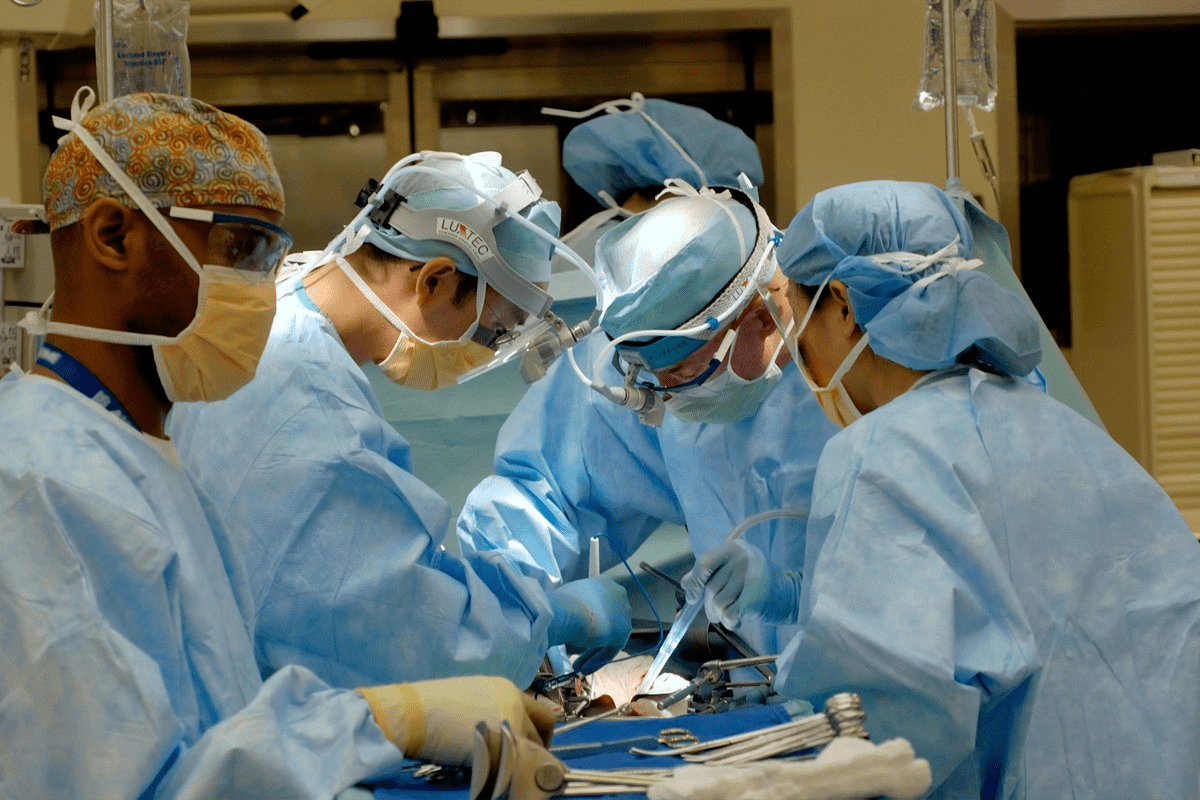Last Updated on November 27, 2025 by Bilal Hasdemir

At Liv Hospital, we are leading the way in medical innovation. We know that effective cancer care goes beyond old methods. Our goal is to give patients the latest in cancer cell treatment for the best care.
Today, patients and doctors have many ways to fight treating cancer disease. We’re looking at eight new kinds of cancer treatment. These are changing how we treat cancer and shaping its future.
Key Takeaways
- Eight essential cancer treatment options beyond chemotherapy.
- Innovative therapies improving patient results.
- Advanced medical treatments for full care.
- Many choices for patients and doctors.
- Changing cancer care with new therapies.
The Evolving Landscape of Cancer Care
Our knowledge of cancer is growing, leading to more treatment options for cancer. This change comes from new medical research and technology. It lets doctors create treatments that fit each patient’s needs.
Moving Beyond Traditional Approaches
Chemotherapy has long been a key part of cancer treatment. But now, we’re seeing more diverse and focused therapies. Treatments for cancer other than chemotherapy, like immunotherapy and targeted therapy, are gaining ground. They promise better results with fewer side effects.
The Importance of Treatment Diversity
Having many cancer treatment options is key to better patient care. It lets doctors create more effective plans. This variety also encourages new ideas in cancer research.
| Treatment Type | Description | Benefits |
|---|---|---|
| Chemotherapy | Uses drugs to kill cancer cells | Effective for various cancer types |
| Immunotherapy | Boosts body’s immune system to fight cancer | Potential for long-term remission |
| Targeted Therapy | Targets specific cancer cell characteristics | Reduced harm to healthy cells |
Cancer Treatments List: 8 Options Transforming Oncology
Cancer treatment has made big strides, giving patients more choices than just chemotherapy. Today, we have a wide cancer treatments list with new therapies for each patient’s needs.
The growing list of cancer fighters includes:
- Immunotherapy
- Targeted therapies
- Hormone therapy
- Radiation therapy
- Surgery
- Chemotherapy
- Stem cell transplantation
- Precision medicine
The Expanding Arsenal Against Cancer
Oncology has seen a lot of new treatments. Immunotherapy uses the body’s immune system to fight cancer. Targeted therapies aim at specific cancer growth points. These new methods are changing how we treat cancer.
How Oncologists Develop Treatment Plans
Oncologists plan treatments based on many factors. They look at the cancer type, stage, patient health, and new research. We use a personalized approach, mixing therapies for the best results. For example, docetaxel-based therapy is used for gastric cancer, showing the need for custom plans.
By using the latest research and considering each patient’s needs, we create effective plans. This approach helps improve patient outcomes.
Surgery: Precision Removal of Cancer Tissue
Surgery is a key part of treating many cancers. It offers a precise way to remove cancerous tissue. As treatments get better, so do surgical methods. This gives patients more and better options.
Types of Cancer Surgery Procedures
Cancer surgery includes many procedures, each for different cancers and needs. The right surgery depends on the tumor’s location, size, and stage.
Minimally Invasive Techniques
Minimally invasive surgery has changed cancer treatment a lot. It cuts down recovery time and scarring. Laparoscopic and robotic surgeries use small cuts to remove tumors with great precision.
Traditional Surgical Approaches
Open surgery is also important for many patients, mainly for big or complex tumors. It lets surgeons get direct access to the tumor. This way, they can remove all the cancerous tissue.
Optimal Scenarios for Surgical Intervention
Surgery works best when cancer is caught early and is in one place. In these cases, it can cure the cancer by removing the tumor. Doctors and oncologists work together to find the best treatment. They consider the patient’s health, cancer stage, and surgery’s benefits and risks.
A leading oncologist once said,
“Surgery is not just about removing the tumor; it’s about giving patients a second chance at life.”
Knowing you’ll have surgery can be scary. But with new surgical methods and care after surgery, many patients do well. They get to live better lives.
Radiation Therapy: Targeted Energy to Destroy Cancer Cells
Radiation therapy is a key part of cancer treatment. It uses high-energy particles or waves to kill cancer cells. This method aims to destroy cancer cells while protecting healthy tissue.
At our institution, we use the latest in radiation therapy. We create treatment plans that fit each patient’s needs.
External Beam Radiation vs. Brachytherapy
Radiation therapy comes in two main types: external beam radiation therapy (EBRT) and brachytherapy. EBRT sends radiation from outside the body to the tumor. Brachytherapy places radioactive material close to or in the tumor.
Each method has its benefits. The choice depends on the cancer’s type, size, and location.
Advanced Radiation Technologies
The field of radiation oncology has made big strides. New technologies like Intensity-Modulated Radiation Therapy (IMRT) and proton therapy have improved. These advancements help target tumors more precisely, reducing harm to healthy tissues.
Intensity-Modulated Radiation Therapy (IMRT)
IMRT is a complex radiation therapy. It changes the radiation beam’s intensity to match the tumor’s shape. This method allows for more radiation to be given to the tumor while protecting nearby tissues.
Proton Therapy and Stereotactic Approaches
Proton therapy uses protons to kill cancer cells. It’s very precise and has fewer side effects. Stereotactic body radiation therapy (SBRT) gives high doses of radiation in a few fractions. It’s effective for some cancers.
Immunotherapy: Activating the Body’s Defense Systems
Immunotherapy is a new way to fight cancer by using the body’s immune system. It has changed how we treat cancer, giving hope to people all over the world.
Checkpoint Inhibitors and Cancer Vaccines
Checkpoint inhibitors help the immune system fight cancer better. Cancer vaccines help the body recognize and attack cancer cells. These vaccines can stop cancer from starting or treat it if it does.
Success Rates and Clinical Outcomes
Studies show checkpoint inhibitors and cancer vaccines are working well. For example, they have greatly increased survival rates in some melanoma and lung cancer patients.
| Cancer Type | Treatment | Success Rate |
|---|---|---|
| Melanoma | Checkpoint Inhibitors | 40% |
| Lung Cancer | Cancer Vaccines | 30% |
Managing Side Effects
Immunotherapy can be very effective but also has side effects. It’s important to manage these to get the best results for patients.
CAR T-Cell Therapy and Emerging Approaches
CAR T-Cell therapy is another immunotherapy method. It takes T cells from the blood, changes them to fight cancer, and then puts them back. It’s shown great promise in treating some blood cancers.
New and exciting ways to use immunotherapy are being discovered. Researchers are exploring combination therapies that mix different immunotherapies with other cancer treatments.
Targeted Therapies: Precision Medicine in Action
Targeted therapies are a big step forward in cancer treatment. They use precision medicine to change how we treat cancer. These treatments aim at specific molecules or pathways in cancer cells, making treatment more personal.
Molecular Mechanisms of Targeted Drugs
Targeted drugs find and attack specific molecules linked to cancer. Some stop certain proteins in cancer cells from working. Others block signals that help tumors grow. These treatments are more precise, leading to better cancer control with fewer side effects.
A top oncologist says, “Targeted therapies have changed how we fight cancer. They give new hope to patients who didn’t respond to other treatments.”
“The development of targeted therapies has been a game-changer in oncology, providing hope for patients with previously untreatable cancers.”
Applications in Breast, Lung, and Other Cancers
Targeted therapies are making a big difference in treating cancers like breast, lung, and colorectal. For example, HER2-targeted therapies have helped patients with HER2-positive breast cancer. EGFR inhibitors are now a key treatment for some lung cancers.
The success of targeted therapies depends on genetic testing and biomarkers. These tools help find the right treatment for each patient. Biomarkers like HER2 in breast cancer or EGFR in lung cancer guide treatment choices.
Overcoming Resistance Mechanisms
One big challenge is when cancer cells become resistant to targeted therapies. Scientists are working on new treatments and combinations to keep therapies effective. By learning more about how resistance happens, we can improve treatment outcomes for patients.
Hormone Therapy and Stem Cell Transplantation
Hormone therapy and stem cell transplantation are big steps in fighting cancer. They help manage different types of cancer, mainly those that are hormone-sensitive or blood-related.
Hormone Therapy for Hormone-Sensitive Cancers
Hormone therapy works well for cancers that hormones affect, like some breast and prostate cancers. It either lowers hormone production or blocks their effects. This helps slow or stop tumor growth.
Breast and Prostate Cancer Applications
In breast cancer, hormone therapy targets tumors that respond to estrogen. For prostate cancer, it focuses on androgens. These methods have greatly helped patients with these cancers.
Managing Treatment Effects
Hormone therapy can have side effects, like hot flashes and mood swings. It’s important to manage these to keep patients’ quality of life good.
Stem Cell Transplantation in Blood Cancers
Stem cell transplantation is key for blood cancers, like leukemia and lymphoma. It replaces bad bone marrow with healthy stem cells, from the patient or a donor.
This method lets doctors use strong chemotherapy or radiation. Then, they give stem cells to fix the bone marrow. It’s a big hope for many blood cancer patients, aiming for long-term recovery or cure.
Innovative Local Treatments: Photodynamic Therapy and Ablation
Cancer treatment is changing fast. New local treatments are becoming more common. They give hope to those with tumors, as alternatives to old methods.
Photodynamic Therapy: Light-Activated Treatment
Photodynamic therapy (PDT) is a non-invasive way to fight cancer. It uses light-sensitive compounds that kill cancer cells when exposed to light. PDT works well for surface tumors and some skin cancers.
Ablation Techniques for Localized Tumors
Ablation techniques destroy cancer cells directly. They are great for tumors that don’t respond to other treatments.
Radiofrequency and Cryoablation
Radiofrequency ablation (RFA) heats cancer cells with electrical energy. Cryoablation freezes them. Both are done outside the hospital and are less invasive.
Candidate Selection and Outcomes
Choosing the right patient for ablation is key. Tumor size, location, and health matter. Research shows good results for those treated, with big tumor reductions.
Photodynamic therapy and ablation are changing cancer treatment. They give patients more choices and better results.
Conclusion: Personalized Medicine and the Future of Cancer Care
Personalized medicine is changing how we fight cancer. It makes treatment plans fit each patient’s needs. This approach can make treatments work better and improve life quality.
Today, we have many ways to treat cancer, like surgery and new medicines. We use genetic tests to find the best treatment for each person. This makes treatment plans more precise.
Personalized medicine is all about being precise and caring. It uses the latest technology and knows what patients need. We aim to give care that works well and shows compassion. Our goal is to keep improving cancer treatment and support patients from around the world.
FAQ
What are the main cancer treatment options beyond chemotherapy?
We offer many treatments like immunotherapy and targeted therapies. We also have hormone therapy, surgery, and radiation therapy. Other options include stem cell transplantation, photodynamic therapy, and ablation techniques.
How do oncologists develop treatment plans for cancer patients?
Our oncologists plan treatments based on the latest research and the patient’s needs. They consider the cancer type and stage to give personalized care.
What is the role of surgery in cancer treatment?
Surgery removes cancer tissue with precision. We use both minimally invasive and traditional surgical methods.
What are the different types of radiation therapy used in cancer treatment?
We use external beam radiation and brachytherapy. We also have advanced technologies like IMRT and proton therapy to target cancer cells.
How does immunotherapy work in cancer treatment?
Immunotherapy boosts the body’s defense against cancer. It uses checkpoint inhibitors, cancer vaccines, and CAR T-cell therapy.
What are targeted therapies, and how are they used in cancer treatment?
Targeted therapies are medicines that target cancer growth. We use them to treat cancers like breast and lung cancer.
What is hormone therapy, and how is it used in cancer treatment?
Hormone therapy treats hormone-sensitive cancers by managing hormone levels. It improves treatment outcomes for these patients.
What is stem cell transplantation, and how is it used in cancer treatment?
Stem cell transplantation treats blood cancers by replacing damaged stem cells. It improves outcomes for these patients.
What are innovative local treatments, and how are they used in cancer care?
Innovative local treatments, like photodynamic therapy and ablation, treat localized tumors. They provide precision medicine in cancer care.
How does personalized medicine improve cancer treatment outcomes?
Personalized medicine tailors treatments to individual patients. It enhances quality of life and treatment effectiveness.
What are the benefits of treatment diversity in cancer care?
Treatment diversity offers patients more options. It improves outcomes and quality of life. We use it to provide international patients with complete healthcare services.
References
- Nature: https://www.nature.com/articles/d42473-019-00064-0
- National Cancer Institute (NCI): https://www.cancer.gov/news-events/cancer-currents-blog/2023/neoadjuvant-immunotherapy-only-treatment
- Cancer Research Institute (CRI): https://www.cancerresearch.org/blog/difference-cancer-immunotherapy-and-chemotherapy
- National Center for Biotechnology Information (NCBI) / PMC: https://pmc.ncbi.nlm.nih.gov/articles/PMC9655090/
- Cancer Treatment Centers of America (CTCA): https://www.cancercenter.com/community/blog/2024/05/does-immunotherapy-work-for-everyone








